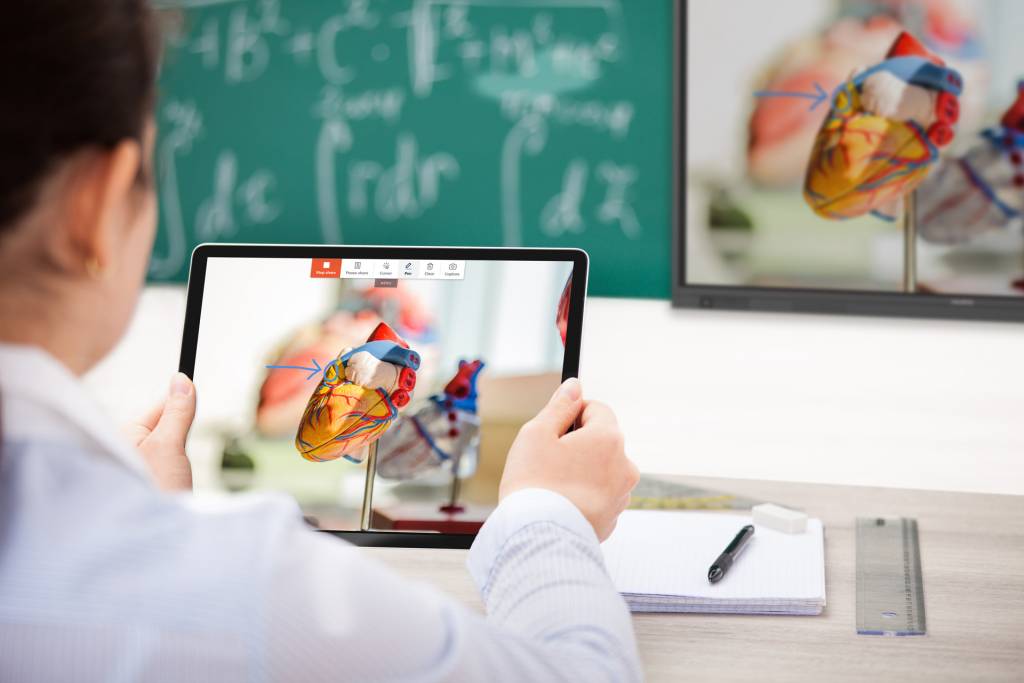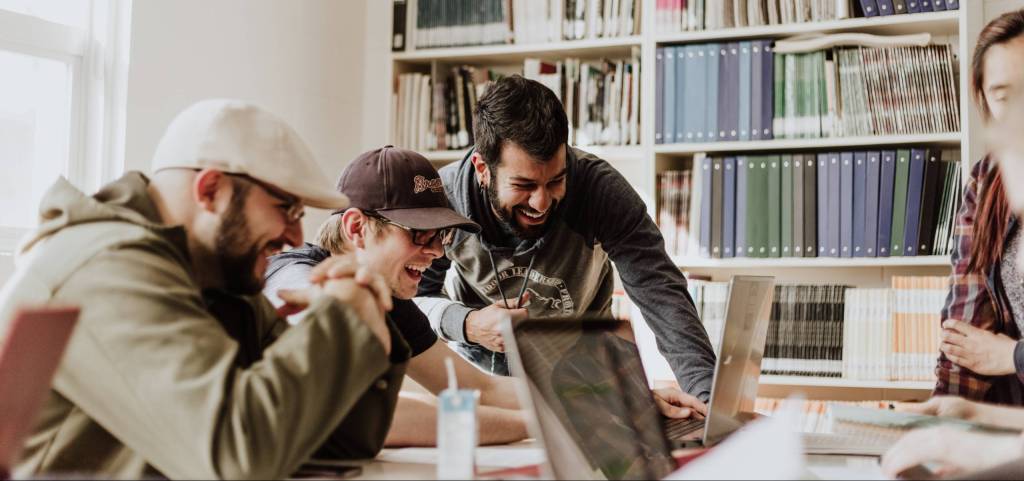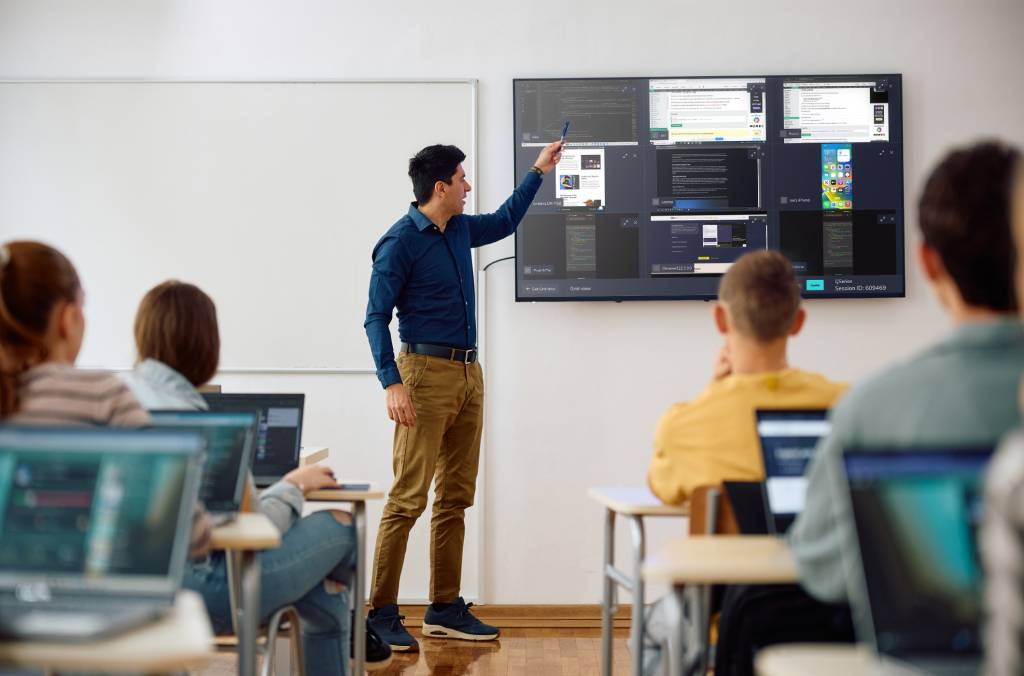
Teaching Times: How Screen Sharing Is Changing The Way We Teach
 Julie Adams
•
Aug 9, 2021
Julie Adams
•
Aug 9, 2021
The following is taken from an article published by Teaching Times on 4th July 2021.
It’s easy to forget how online teaching has changed since the pandemic started, but companies such as DisplayNote are making teachers ever more responsive to student needs as Sal McKeown reports.
What we have learnt
I recently came across this survey from Teacher Tapp, an app that asks teachers from all sectors three quick questions every day at 3.30 and gathers their responses. It is an invaluable tool for schools that want to see how they compare to others and provides insights into CPD. But it is also proving a good way of recording the story of education in our times.

Nearly half of state primary schools in the survey made children take home physical workbooks and worksheets. There was a sharp divide between state and private schools. ‘Private school secondary teachers are by far the most likely to be using online video conferencing (27%) or online chatting programmes (17%). In part, this might be because these programmes are more expensive and because it assumes that students will have their own device and access to the internet that’s good enough to stream video.’ In contrast, just 1% of state primaries were set up and using online video conferencing and 3% had a facility for online chat.
As lockdown bit, schools learned that hard copies only worked if children could collect them at school and take them home because few had printers. Also, hard copies do not make for interactive learning that responds to learners’ needs, especially if the gap between doing the work and receiving the teachers’ marks and comments is spread over several weeks.
This accelerated the move to online learning and schools had to find technology and distribute it as fairly as possible. We have covered the Digital Divide in many other articles and cannot pretend that the move to online learning met all students’ and teachers’ needs, nor was it equitable, but it did become the main delivery method in most schools.
It would be fair to say that many saw it as a poor relationship and were longing to get back to face-to-face teaching. However, some teachers have adopted the new technology whole-heartedly and adapted their teaching methods with great success.
Why screen sharing matters
DisplayNote has been one of the success stories of the pandemic. Paul Brown founded the company in Belfast in 2012. Originally it was an AV company focusing on presentation technology. In recent times it has moved beyond the front-of-room display to think about how people want to present their content in a virtual world.
Now DisplayNote has offices in both Northern Ireland and Spain. The focus is on sharing and collaboration and their work with educators across the world is adding to our knowledge of how to deliver remote, hybrid and blended learning.
If you’ve ever let tech support take over your computer, then you’ve experienced screen sharing. In meetings and lessons, it lets the presenter show the different steps in a process so it is ideal for maths and science and for annotating a text in literature classes.
Jaime Miller is the director of the online school English Success Academy. She has found screen sharing makes her more responsive to students’ needs. She believes it is vital to see: ‘what your students are looking at, or what their mouses are hovering on, or what they’ve typed. This way, I can adjust the pace of the lesson to make sure everyone is comfortable.’
She feels that screen sharing is not an optional feature of an ESL teaching platform. ‘You need it so you can respond spontaneously to tech challenges or questions about grammar or vocabulary that pop up in a one-to-one ESL lesson. It’s also what makes or breaks an online reading or writing lesson.’
DisplayNote’s collaboration tools let students at home and in class share content. Broadcast is a one-to-many sharing tool that allows the teacher to share their screen with all the students’ devices. Montage enables wireless content sharing from any personal device on any network, to a large-format display in the classroom, for example, an interactive whiteboard. Students share what’s on their screen with the rest of the class, and teachers can share what’s on their display to their students’ devices.
Improving access
Lega del Filo d’Oro is an Association in Osimo, Italy, that works with children with severe sensory difficulties. For over 50 years, the Association has been assisting, educating, rehabilitating, and reintegrating deafblind children back into society to give them more personal autonomy in their lives.
Some children have a small amount of sight so teachers wanted a quick and easy way to share content from their personal devices to a large touch screen at the front of the classroom that displays content in a larger format.
They are using the Montage tool which has many advantages:
- No trailing wires that could be especially hazardous for children with limited sight
- Teachers can share screens from tablets, laptops or desktop machines
- They can annotate the screen so students see and follow a process
- They can screen share across any network
- Students can screen share from their own devices so they can see one another’s work
Introducing screen sharing into the classroom
Rachel Prince is a teacher at Horizon High School, Arizona. As with many teachers in the UK, when Covid struck she found that she had a quarter of the class checking in from home. In the beginning, the class relied on worksheets that Rachel had to prepare and hand out. She moved on to Google Meet using video and audio to bring students who were working from home into the classroom. The trouble was that this led to front-of-the-class teaching, but Rachel wanted less of a formal presentation style and more sharing and engagement.
Rachel created a workaround solution by angling her web camera, so students could see what was on the board. But this brought its own problems:
- It was hard to ensure that the webcam was set at the right angle to capture the entire screen
- Tilting the camera up, then down again, disrupted the lesson flow
- Students at home could not always read what was on the board
- Students could not see Rachel and the board at the same time
Again, this ended up being a presentation technique and interactions were contrived. There were problems too on the home front. Some homes had poor connectivity and too few devices, especially if parents were working from home. Once she discovered Display Note she could share her screen with students, plus they could share screens with one another and show up to four students’ work on the main display at the same time with Grid View.
Rachel has found all students can join the session regardless of what type of device they own: “All the kids have to do is go to the DisplayNote webpage to join. My students love the apps for IOS and Android. They all have their own phones, which they can use to connect and present their work. It’s a technology that is familiar and accessible.”
Best of all everyone can see the same content: “I know that whatever is on the board is being viewed by the kids in the room and out of the room; there’s no need to keep asking if everyone can see what I see. There are no more questions from students asking me to show something again.”
What DisplayNote has learnt from their users
The company surveyed a sample of 250,000 users to find out more about their habits. It seems that hybrid learning, and app deployment policies all contribute to the web being used more often for screen sharing.
Of course, mobile screen sharing is very popular. With 69% of 12-year-olds owning a mobile phone, it’s no surprise that mobile app counts for 37% of all shares. More surprisingly, while the internet is generally in use, some users choose to run sessions with zero connectivity to the internet.
In education, screen sharing is now moving to a model where several people contribute and share their content rather than a static presentation from the teacher such as a PowerPoint. This is partly because of the annotation tools. These were used during 43% of screen shares by both teachers and students to focus on particular aspects.
Changing the pedagogy
Teachers have also started to reflect on the change that technology has brought. Dr. Anthea Irwin, a Lecturer in Communication at Ulster University, has found that the move to blended learning has had many advantages.

The courses she teaches were all online with a mixture of asynchronous and synchronous delivery. Students would often have things to watch, reflect on and prepare before joining a face-to-face taught session. The ‘anytime, anywhere’ aspects of the course benefited students with jobs or caring responsibilities but they needed to plan to make sure they did justice to both types of work. But it also meant that she as a teacher had to change the way she structured and presented content.
Anthea found that making online content for students is not as simple as sitting down in front of a mic and talking through your lecture slides as students can switch off. She ‘curated’ the material differently with several shorter pieces rather than one long one and used far less text and many more images so materials were more visual. She planned her content so that she could draw students in with questions, lots of humor, and some direct ‘piece to camera’ sections to humanize the content. She also provided transcripts of what she had said and introduced opinion polls, quizzes, mood scales, and free text answer activities.
Anthea found that sessions worked better when there had been structured pre-session tasks. Using Broadcast in conjunction with DisplayNote Montage, students contributed more, sometimes sharing their screens to talk the rest of the class through what they had done.
“And here’s the thing – my students loved it,” said Dr. Irwin. “The rebalancing of text and visual worked for those who are visual learners. Having the transcripts as a basis for notes worked for those who live with dyslexia. Being able to watch and listen again worked for everyone. There is no doubt in my mind that my students’ learning was deeper in this format.”
Find the right tool for your classroom
Want to stay in the loop?
Keep up-to-date with everything DisplayNote – including new releases, job openings, and customer giveaways.
Don’t worry, we’ll not spam you and we’ll never share your email with anyone








